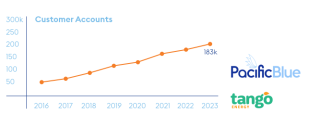As the nation's fossil-fuel energy giants implement their net-zero transitions, the grandfather of renewables, Pacific Blue, is more concerned with stability than reinvention, despite some ambitious growth plans.
Pacific Blue, established as Pacific Hydro in 1992, developed the first commercial wind farm in Australia at Codrington near Port Fairy in southwest Victoria.
While perfectly positioned with strong prevailing winds blowing off the Southern Ocean, the 18MW facility, opened by then-premier Steve Bracks in 2001, is almost a museum piece, with the useful life of wind turbines now measured in dog years.
"Codrington has only fourteen towers and it's not commercially worth it today to build a wind farm with less than 200MW-300MW of generation," Pacific Blue chief executive Domenic Capomolla said.
"The reality is that the towers today are three times taller and the blades twice as big. That's another limiting factor, so we'll probably have to start pulling Codrington down in the next few years.
"We'll continue to grow, but only in renewable generation like it's always been."
Growth is very much on Pacific Blue's agenda, as the company contributes to the Federal Government's 82 per cent renewable energy target by 2030, up from its current level of around 40 per cent.
It also owns and operates two fast-growing retail brands - Pacific Blue and Tango Energy - with over 180,000 customers.

Retail customer growth builds demand for the company's development projects and contributes to the broader energy transition.
Pacific Blue has an installed capacity of 665MW from its diversified portfolio of wind, solar and hydro assets.
The key feature of Mr Capomolla's strategy is a four-fold increase in generation and storage capacity to 2.5GW over the next 8-10 years, as emissions-heavy coal-fired power is progressively retired from the system.
Of the 2.5GW, wind is expected to comprise 1.1GW, with 250MW in pumped hydro, 200MW in solar and about 600MW in batteries.
"The market needs the extra capacity," the Pacific Blue chief said.
"Governments have set targets to replace coal, and the back-of-the-envelope numbers say that you need about five units of renewable generation, including batteries, to replace one unit of coal, because coal runs all the time and renewables only run 25-30 per cent of the time."
While Pacific Hydro began as a hydro developer, it was rebadged as Pacific Blue in 2023 to reflect its diversified portfolio of renewables.
The company faced a challenging period in the mid-2010s amid policy uncertainty and extremely low wholesale power prices.
Pacific Hydro responded with a restructure, ahead of its owner, IFM Investors, selling the business a year later to the State Power Investment Corp of China for more than $3bn, including debt.
Mr Capomolla said the current policy environment was more settled, with renewables now regarded as a "must-have" rather than a "nice-to-have".
"Governments are certainly friendlier - they set the targets and we're the

folks who deliver them, and as much as we complain about the hurdles that governments put in our way, they're actually trying to remove those hurdles as best they can," he said.
"The banks are also friendlier, but the economics aren't as strong as they were back in 2000, although I'm expecting they'll improve.
"Building a solar farm is difficult because solar operates during the day when the wholesale price is often negative. It begs the question – who's going to build a piece of kit that requires you to pay money to get dispatched?
"But you can still make a reasonable return on a wind farm."
Negative wholesale or spot pricing from a flood of solar during the day is a relatively recent phenomenon due to the massive take-up of rooftop solar by a third of Australian households.
Rooftop solar is a bigger contributor to the grid than the combined output from utility-scale renewable operations, driving energy prices down in peak periods of availability.
This requires batteries or conventional generators to step in when the wind isn't blowing or the sun isn't shining.
The problem becomes more challenging as coal-fired generators near retirement, which is why their productive lives have in some cases been extended.
"The transition of removing coal-fired generation over the next 8-10 years will create these bumps and anomalies in the market," Mr Capomolla said.
"Pumped hydro storage is being built and will provide more firming (to keep the grid stable and counter-balance intermittent renewables) but it takes forever to build and plan, and battery technology is accelerating in terms of storage and how much you can dispatch.
"But we're in this 10-year window of transition where we'll continue to have these big fluctuations in pricing during the day."
Mr Capomolla said the company would leave offshore wind to specialist operators, and had been outbid for projects in NSW Renewable Energy Zones.
"We thought the prices were very high for access to those zones, so we just failed in our bid because our pricing was too low; it wasn't a conscious decision," he said.
"But we've got a very robust pipeline which is going to keep us busy for the next 10-15 years.
The Pacific Blue boss strongly backed the Federal Government's expansion of the Capacity Investment Scheme (CIS) last November, which will target 32GW of new capacity including 23GW of renewables representing $52bn of investment and 9GW of clean dispatchable capacity worth $15bn.
Canberra has said it will provide revenue underwriting for successful CIS tenders, with an agreed floor and ceiling.
The objective is to create a long-term revenue safety net to lower financial risks for investors and encourage more investment where it is needed.
Mr Capomolla applauded the scheme, saying it would provide sufficient certainty for bank funding.
"No battery subject to volatile 5-minute pricing blocks in the spot market has been funded by banks in Australia; you need an offtake agreement to create the required level of certainty," he said.
Pacific Blue is currently the nation's 10th biggest generator, but Mr Capomolla said it could conceivably jump to 7th once its expansion program has been completed.
It's not a position that he is seeking or expects to hold for very long, given the company's peers have expansion plans of their own.
"By the time we get to 2.5GW, others will overtake us," he said.
"But that's OK, we don't care how big we are. I'd rather stay under the radar and just do what we do very well.
"We're a highly regulated industry – from a retail perspective the average bill is $1200 a year, yet we have greater scrutiny and regulation than banks or insurance companies.
"So keep under the radar, do what you do well, get on with the business and do it efficiently."






